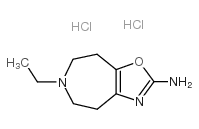Characterization of postjunctional alpha-adrenoceptors in the pithed mouse.
G P McCafferty, D P Naselsky, J P Hieble
Index: Gen. Pharmacol. 33(1) , 99-105, (1999)
Full Text: HTML
Abstract
The adrenoceptor subtypes responsible for the pressor response to alpha1- and alpha2-adrenoceptor agonists have not yet been established, although gene knockout experiments in the mouse have provided evidence for a role of the alpha1B- and alpha2B-adrenoceptor. We have evaluated the blood pressure response to selective activation of postjunctional alpha1- and alpha2-adrenoceptors in the pithed mouse. The pressor response to phenylephrine was sensitive to blockade by terazosin, a selective alpha1-adrenoceptor antagonist, but insensitive to rauwolscine, an antagonist at alpha2-adrenoceptors. Phentolamine, a nonselective alpha-adrenoceptor antagonist, blocked the response to either phenylephrine or the selective alpha2-adrenoceptor agonist B-HT 933, whereas rauwolscine blocked only B-HT 933. A dose of terazosin effective against phenylephrine had no effect on B-HT 933; however, the B-HT 933 response was antagonized when the terazosin dose was increased tenfold. A high dose of doxazosin, an alpha1-adrenoceptor antagonist having no affinity for the alpha2B adrenoceptor, blocked the response to phenylephrine but not B-HT 933. Comparison of the potencies of these antagonists against the pressor response to phenylephrine with their affinities for recombinant alpha1-adrenoceptor subtypes suggests that this response is mediated by either alpha1B- or alpha1D-adrenoceptors. The alpha2B-adrenoceptor subtype is likely to take part in the response to B-HT 933. The ability of certain quinazoline alpha1-adrenoceptor antagonists to block the alpha2B adrenoceptor may contribute to their activity as antihypertensive agents.
Related Compounds
| Structure | Name/CAS No. | Molecular Formula | Articles |
|---|---|---|---|
 |
Azepexole dihydrochloride
CAS:36067-72-8 |
C9H17Cl2N3O |
|
The role of several alpha(1)- and alpha(2)-adrenoceptor subt...
2001-03-01 [Br. J. Pharmacol. 132 , 1292-1298, (2001)] |
|
Pharmacological evidence that alpha2A- and alpha2C-adrenocep...
2007-01-12 [Eur. J. Pharmacol. 554(2-3) , 205-11, (2007)] |
|
Evidence that some imidazoline derivatives inhibit periphera...
2008-12-05 [Auton. Neurosci. 143(1-2) , 40-5, (2008)] |
|
Inhibition of placental 11beta-hydroxysteroid dehydrogenase ...
2001-12-01 [Am. J. Physiol. Regul. Integr. Comp. Physiol. 281(6) , R1966-74, (2001)] |
|
Role of the eNOS Glu298Asp variant on the GNB3825T allele de...
2003-05-01 [Pharmacogenetics 13(5) , 279-84, (2003)] |